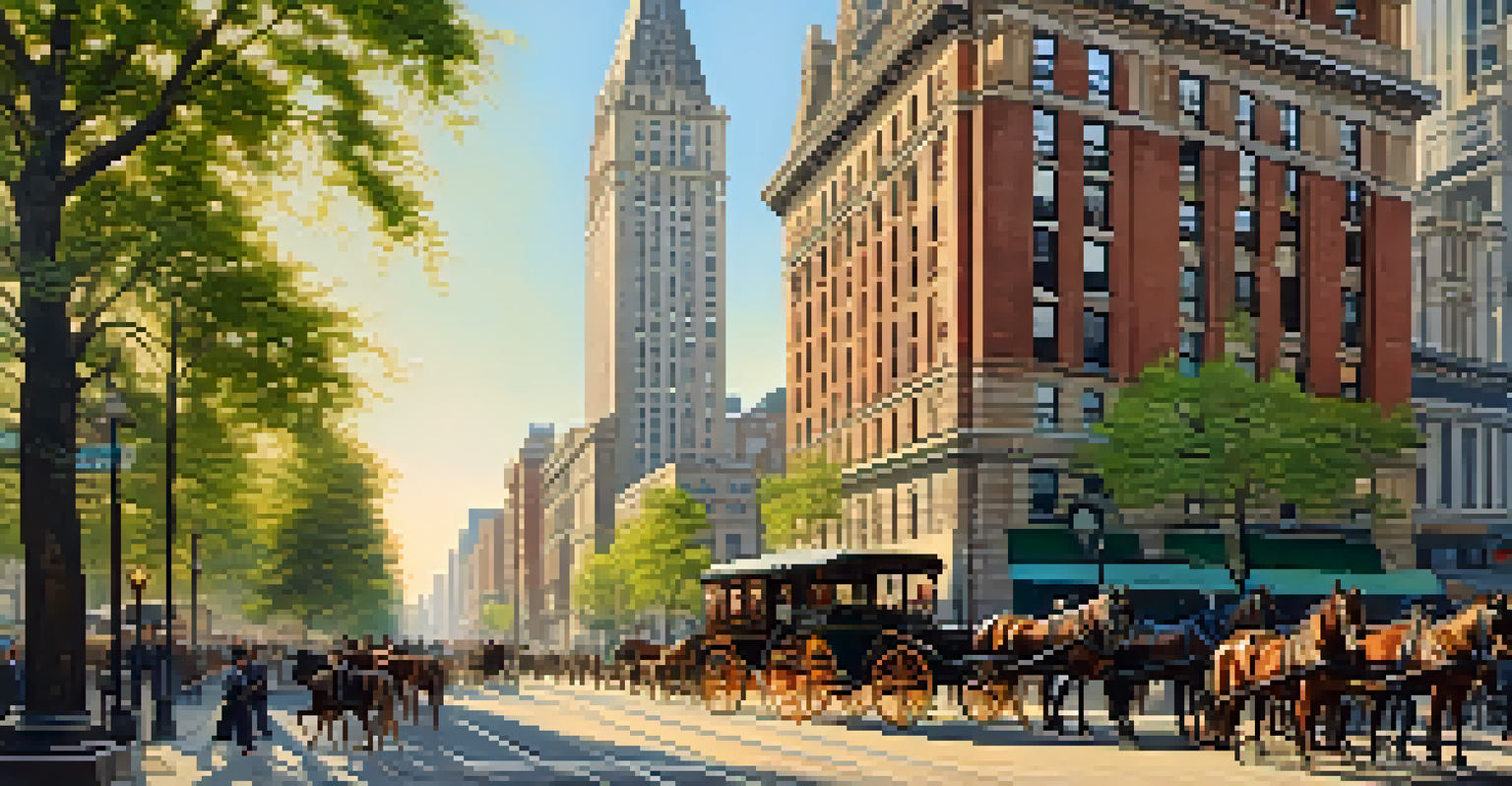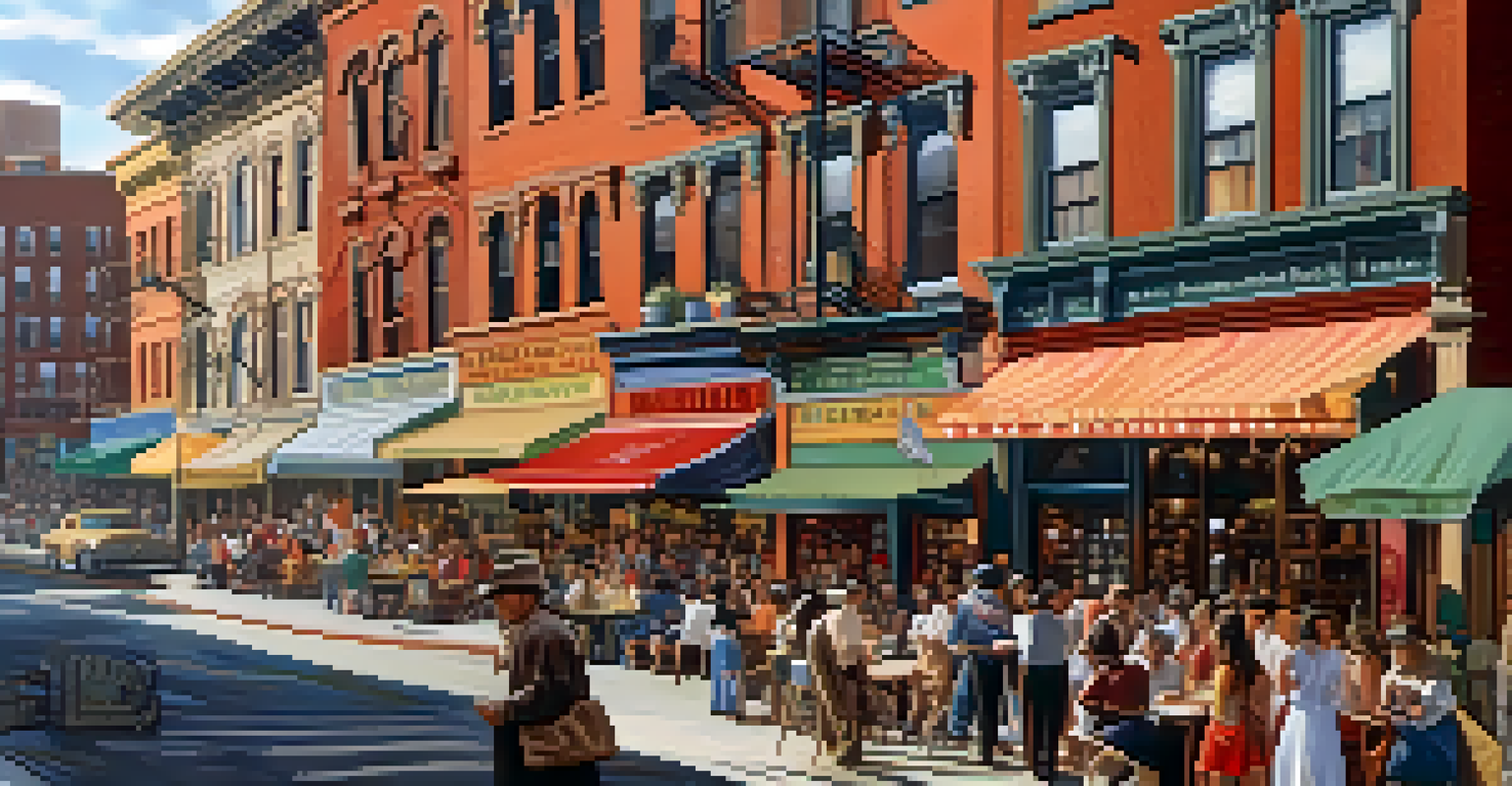The Rise of Manhattan: Urban Development in the 19th Century

The Early Foundations: Manhattan's Origins
Manhattan's journey as an urban center began long before the 19th century, rooted in its early settlement by the Dutch in the 1600s. This small trading post, known as New Amsterdam, laid the groundwork for what would become a vibrant metropolis. The strategic location of the island along the Hudson River made it a prime spot for commerce and trade, attracting settlers from various backgrounds.
New York is not a city; it's a world.
As the years rolled on, Manhattan transformed from a quiet settlement into a booming hub of activity. The British takeover in the late 17th century further propelled its growth, setting the stage for an influx of immigrants and diverse cultures. This melting pot of ideas and industries would play a crucial role in shaping the development of the city in the following century.
By the early 1800s, Manhattan was no longer just a trading post; it was evolving into a key player in the emerging American economy. With its population steadily increasing, the island began to lay the groundwork for the urban landscape that would define the 19th century.
The Impact of Infrastructure: Roads and Railways
In the 19th century, the development of infrastructure was paramount to Manhattan's urban evolution. The introduction of paved roads and the expansion of the street grid system facilitated easier movement throughout the city. This improvement in transportation not only enhanced daily commutes but also opened up new areas for development and commerce.

As the century progressed, railways began to crisscross the city, connecting Manhattan to the greater New York area and beyond. The construction of the first elevated railway in 1868 and the completion of the subway system in the early 20th century revolutionized urban travel. Suddenly, residents could traverse the island with unprecedented ease, leading to increased accessibility and urban sprawl.
Manhattan's Diverse Origins
Manhattan's transformation from a Dutch trading post in the 1600s to a bustling urban center reflects its rich history of immigration and cultural diversity.
These advancements in transportation were not just about convenience; they played a vital role in shaping the city’s economy. With easier access to markets and resources, businesses flourished, and Manhattan became a focal point for trade and industry.
The Rise of Skyscrapers: Architectural Innovations
The late 19th century marked a significant architectural shift in Manhattan, thanks to the advent of steel-frame construction. This innovation allowed buildings to reach new heights, literally transforming the skyline. The Home Insurance Building, completed in 1885, is often credited as the world's first skyscraper, paving the way for future developments that would redefine urban architecture.
The great thing about New York is that it’s always changing, and you can always feel that energy.
As more architects and developers embraced this new style, iconic structures began to emerge throughout the city. The Flatiron Building, completed in 1902, and the Woolworth Building, finished in 1913, showcased the creative potential of steel and reinforced concrete. These towering edifices not only provided much-needed office space but also became symbols of Manhattan’s burgeoning identity.
The rise of skyscrapers also reflected the ambitions of a growing metropolis. With each new building, Manhattan asserted its place as a global center for commerce and culture, attracting businesses and residents alike to its bustling streets.
Population Boom: Immigration and Urbanization
The 19th century was a period of massive immigration, with millions of individuals arriving at Manhattan's shores seeking a better life. Many hailed from Europe, fleeing famine, war, and economic hardship, while others came from Asia and Latin America. This influx of diverse populations contributed to a rapid increase in the city's population, which would ultimately change the fabric of Manhattan society.
As neighborhoods filled with new residents, cultural enclaves began to form, each adding its unique flavor to the city. The Irish settled in the Five Points area, while Italian immigrants established Little Italy. These communities became hubs of activity, filled with shops, restaurants, and social clubs, fostering a sense of belonging in an ever-changing urban landscape.
Infrastructure Fuels Urban Growth
The development of roads, railways, and skyscrapers in the 19th century played a crucial role in shaping Manhattan's economy and urban landscape.
However, the population boom also presented challenges, including overcrowding and inadequate infrastructure. As more people flocked to the city, the need for affordable housing and public services intensified, prompting city planners and government officials to rethink urban policies.
Economic Growth: The Birth of New Industries
The 19th century was also a golden age for Manhattan's economy, with a surge in industries that would shape its future. The rise of manufacturing, finance, and trade created countless job opportunities, drawing even more people to the city. Industries such as textiles, shipping, and finance became the backbone of the urban economy, setting the stage for Manhattan as a global economic powerhouse.
The establishment of Wall Street as the financial center of the nation during this period cannot be overstated. The first stock exchange was founded in 1817, and as the financial sector grew, so did the city's influence. By the end of the century, Manhattan had solidified its position as the financial capital of the United States, attracting investors and entrepreneurs from around the world.
This economic growth was not without its drawbacks, however. The disparity between the wealthy elite and the working class became increasingly pronounced, leading to social tensions and calls for reform. As Manhattan prospered, the stark realities of poverty and labor struggles began to emerge, setting the stage for future social movements.
Cultural Flourishing: Art, Education, and Entertainment
Alongside economic growth, the 19th century saw a remarkable cultural flourishing in Manhattan. The establishment of museums, theaters, and educational institutions contributed to a vibrant arts scene that attracted talent and audiences alike. Institutions like the Metropolitan Museum of Art and the American Museum of Natural History were founded during this time, enriching the cultural landscape of the city.
The theater district began to thrive, with Broadway emerging as the epicenter of American entertainment. The popularity of vaudeville and musicals brought diverse performances to the masses, creating a shared cultural experience that resonated with the city's residents. This cultural melting pot laid the groundwork for Manhattan’s reputation as a hub of artistic innovation.
Cultural and Economic Flourishing
The 19th century saw a remarkable cultural and economic boom in Manhattan, establishing it as a center for arts, education, and finance.
Moreover, the rise of public education and libraries during this era emphasized the importance of knowledge and learning. The establishment of institutions like the New York Public Library reflected a commitment to education, making information accessible to all, regardless of socioeconomic status.
Challenges and Reform: Addressing Urban Issues
As Manhattan thrived, it also faced significant challenges that arose from rapid urbanization. Overcrowding, pollution, and inadequate sanitation became pressing issues, prompting calls for reform. The city struggled to provide basic services to its growing population, leading to public health crises and social unrest.
In response to these challenges, reform movements began to take shape, advocating for improved living conditions and social justice. Activists pushed for better housing regulations, sanitation practices, and labor rights, highlighting the stark contrast between the wealthy elite and the working class. These movements laid the foundation for future reforms that would ultimately transform urban living in Manhattan.

City officials also began to recognize the need for comprehensive urban planning. Initiatives were introduced to address housing shortages, improve public transportation, and expand green spaces. Although these efforts were often met with resistance, they represented a critical step toward creating a more livable and equitable city for all residents.